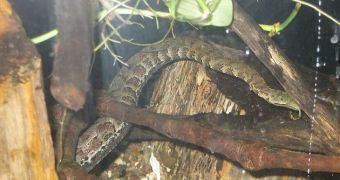Biologists have recently made a significant discovery, when they have found that a certain species of snakes is capable of using small tentacles on its snout to sense its prey and its surroundings. The investigators believe that the creature may be using these structures to make more sense of its environment when insufficient light is available. The aquatic snake (Erpeton tentaculatum) lives in the murky, slow-running waters of Asia, therefore the tentacles make sense, from an evolutionary standpoint, researchers at the Vanderbilt University in Tennessee (VU) say, quoted by PhysOrg.
The US research team was led by biologist Ken Catania, who has been fascinated with these creatures for a long time. The snake is capable of bending its lower body in the shape of the letter “J.” This, in turn, alerts nearby fish that something is off, and they dart out in the opposite direction. Unfortunately for them, that direction is usually occupied by the aquatic snake's opened mouth. This highly specialized form of stalking prey has puzzled scientists upon discovery, given the massive amount of coordination required to make it a reality.
In previous investigations, the scientists had assumed that the tentacles were used exclusively for sensing fish, because this was the aquatic snake's primary source of food. However, when staining the nerve cells in the tentacles with a special dye, and subjecting them to microscope observations, it immediately became apparent that these structures had a lot more nerve cells than expected. Most of these cells were also placed in unusual locations, which did not fall in line with predictions that the tentacles were used solely for fish detection.
The science team hypothesizes that this nerve-cell distribution pattern enables the animal to sense the direction of movement of its entire tentacle, and not feel only touch sensations on its surface. Additionally, the researchers found that stimulating the tentacles tended to produce an increased activity in the snake's visual cortex, which means that the creature may be putting the data it collects from its “antennas” together with visual input from the eyes, to get a better view of its surroundings. The tentacles were found to be sensitive to even the slightest changes in the water currents around the snake.

 14 DAY TRIAL //
14 DAY TRIAL //